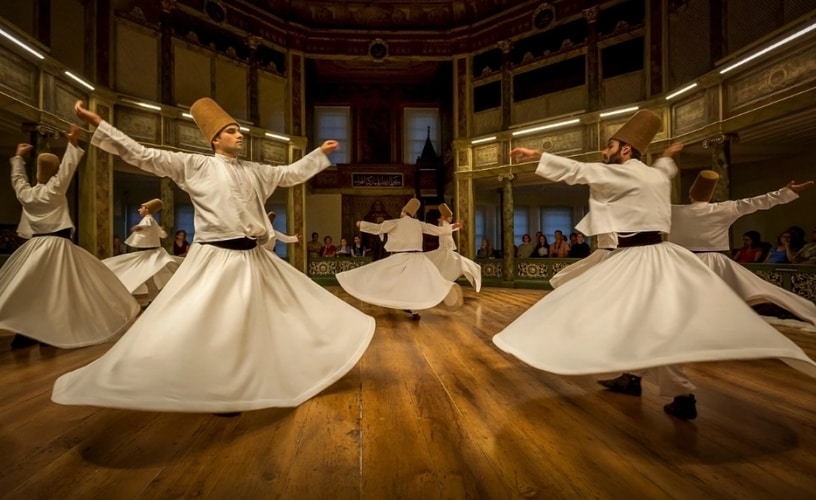What is the Sufism Meaning?
Sufism (Arabic: ٱلصُّوفِيَّة), also known as Tasawwuf (ٱلتَّصَوُّف), is a mystic body of religious practice within Islam characterized by a focus on Islamic spirituality, ritualism, asceticism, and esotericism. It has been variously defined as “Islamic mysticism”, “the mystical expression of the Islamic faith”, “the inward dimension of Islam”, “the phenomenon of mysticism within Islam”, the “main manifestation and the most important and central crystallization” of mystical practice in Islam, and “the interiorization and intensification of Islamic faith and practice”. Practitioners of Sufism are referred to as “Sufis” (from صُوفِيّ, ṣūfīy), and historically typically belonged to “orders” known as tariqa (pl. ṭuruq) – congregations formed around a grandmaster wali who would be the last in a chain of successive teachers linking back to Muhammad.
Sufism Definition:
mystical Islamic belief and practice in which Muslims seek to find the truth of divine love and knowledge through the direct personal experience of God. It consists of a variety of mystical paths that are designed to ascertain the nature of humanity and God and to facilitate the experience of the presence of divine love and wisdom in the world.
Islamic mysticism is called taṣawwuf (literally, “to dress in the wool”) in Arabic, but it has been called Sufism in Western languages since the early 19th century. An abstract word, Sufism derives from the Arabic term for a mystic, ṣūfī, which is in turn derived from ṣūf, “wool,” plausibly a reference to the woolen garment of early Islamic ascetics. The Sufis are also generally known as “the poor,” fuqarāʾ, plural of the Arabic faqīr, in Persian darvīsh, whence the English words fakir and dervish.
Though the roots of Islamic mysticism formerly were supposed to have stemmed from various non-Islamic sources in ancient Europe and even India, it now seems established that the movement grew out of early Islamic asceticism that developed as a counterweight to the increasing worldliness of the expanding Muslim community; only later were foreign elements that were compatible with mystical theology and practices adopted and made to conform to Islam.
By educating the masses and deepening the spiritual concerns of the Muslims, Sufism has played an important role in the formation of Muslim society. Opposed to the dry casuistry of the lawyer-divines, the mystics nevertheless scrupulously observed the commands of the divine law. The Sufis have been further responsible for a large-scale missionary activity all over the world, which continues. Sufis have elaborated the image of the Prophet Muhammad—the founder of Islam—and have thus largely influenced Muslim piety by their Muhammad-mysticism. Sufi vocabulary is important in Persian and other kinds of literature related to it, such as Turkish, Urdu, Sindhi, Pashto, and Punjabi. Through the poetry of this literature, mystical ideas spread widely among Muslims. In some countries, Sufi leaders were also active politically.

History of Sufi:
Islamic mysticism had several stages of growth, including (1) the appearance of early asceticism, (2) the development of a classical mysticism of divine love, and (3) the rise and proliferation of fraternal orders of mystics. Despite these general stages, however, the history of Islamic mysticism is largely a history of individual mystic experience.
The first stage of Sufism appeared in pious circles as a reaction against the worldliness of the early Umayyad period (661–749). From their practice of constantly meditating on the words in the Qurʾān (the Islamic holy book) about Doomsday, the ascetics became known as “those who always weep” and those who considered this world “a hut of sorrows.” They were distinguished by their scrupulous fulfillment of the injunctions of the Qurʾān and tradition, by many acts of piety, and especially by a predilection for night prayers.
Classical mysticism:
The introduction of the element of love, which changed asceticism into mysticism, is ascribed to Rābiʿah al-ʿAdawīyah (died 801), a woman from Basra who first formulated the Sufi ideal of a love of Allah (God) that was disinterested, without hope for paradise and without fear of hell. In the decades after Rābiʿah, mystical trends grew everywhere in the Islamic world, partly through an exchange of ideas with Christian hermits. Several mystics in the early generations had concentrated their efforts upon tawakkul, absolute trust in God, which became a central concept of Sufism. An Iraqi school of mysticism became noted for its strict self-control and psychological insight. The Iraqi school was initiated by al-Muḥāsibī (died 857)—who believed that purging the soul in preparation for companionship with God was the only value of asceticism. Its teachings of classical sobriety and wisdom were perfected by Junayd of Baghdad (died 910), to whom all later chains of the transmission of doctrine and legitimacy go back. In an Egyptian school of Sufism, the Nubian Dhū al-Nūn (died 859) reputedly introduced the technical term maʿ rifah (“interior knowledge”), as contrasted to learnedness; in his hymnical prayers he joined all nature in the praise of God—an idea based on the Qurʾān and later elaborated in Persian and Turkish poetry. In the Iranian school, Abū Yazīd al-Bisṭāmī (died 874) is usually considered to have been representative of the important doctrine of annihilation of the self, fanāʾ; the strange symbolism of his sayings prefigures part of the terminology of later mystical poets. At the same time, the concept of divine love became more central, especially among the Iraqi Sufis. Its main representatives are Nūrī, who offered his life for his brethren, and Sumnūn “the Lover.”
The first of the theosophical speculations based on mystical insights about human nature and the essence of the Prophet Muhammad were produced by such Sufis as Sahl al-Tustarī (died c. 896). Some Hellenistic ideas were later adopted by al-Ḥakīm al-Tirmidhī (died 898). Sahl was the master of al-Ḥusayn ibn Manṣūr al-Ḥallāj, who has become famous for his phrase anā al-ḥaqq, “I am the Creative Truth” (often rendered “I am God”), which was later interpreted in a pantheistic sense but is, in fact, only a condensation of his theory of huwa huwa (“He he”): God loved himself in his essence and created Adam “in his image.” Ḥallāj was executed in 922 in Baghdad as a result of his teachings; he is, for later mystics and poets, the “martyr of Love” par excellence, the enthusiast killed by the theologians. His few poems are of exquisite beauty; his prose, which contains an outspoken Muhammad-mysticism i.e., mysticism centered on the Prophet—is as beautiful as it is difficult.
In these early centuries, Sufi thought was transmitted in small circles. Some of the shaykhs, Sufi mystical leaders or guides of such circles, were also artisans. In the 10th century, it was deemed necessary to write handbooks about the tenets of Sufism to soothe the growing suspicions of the orthodox; the compendiums composed in Arabic by Abū Ṭālib Makkī, Sarrāj, and Kalābādhī in the late 10th century, and by Qushayrī and, in Persian, by Hujvīrī in the 11th century reveal how these authors tried to defend Sufism and to prove its orthodox character. It should be noted that the mystics belonged to all schools of Islamic law and theology of the times.
The last great figure in the line of classical Sufism is Abū Hāmid al-Ghazālī (died 1111), who wrote, among numerous other works, the Iḥyāʾ ʿulūm al-dīn (“The Revival of the Religious Sciences”), a comprehensive work that established moderate mysticism against the growing theosophical trends which tended to equate God and the world—and thus shaped the thought of millions of Muslims. His younger brother, Aḥmad al-Ghazālī, wrote one of the subtlest treatises (Sawāniḥ; “Occurrences” [i.e., stray thoughts]) on mystical love, a subject that then became the main subject of Persian poetry.
Rise of fraternal orders:
Slightly later, mystical orders (fraternal groups centering around the teachings of a leader-founder) began to crystallize. The 13th century, though politically overshadowed by the invasion of the Mongols into the Eastern lands of Islam and the end of the ʿAbbāsid caliphate, was also the golden age of Sufism: the Spanish-born Ibn alʿArabī created a comprehensive theosophical system (concerning the relation of God and the world) that was to become the cornerstone for a theory of “Unity of Being.” According to this theory, all existence is one, a manifestation of the underlying divine reality. His Egyptian contemporary Ibn al-Fāriḍ wrote the finest mystical poems in Arabic. Two other important mystics, who died c. 1220, were a Persian poet, Farīd al-Dīn ʿAṭṭar, one of the most fertile writers on mystical topics, and a Central Asian master, Najmuddīn Kubrā, who presented elaborate discussions of the psychological experiences through which the mystic adept has to pass.
The greatest mystical poet in the Persian language, Jalāl al-Dīn al-Rūmī (1207–73), was moved by mystical love to compose his lyrical poetry that he attributed to his mystical beloved, Shams al-Dīn of Tabriz, as a symbol of their union. Rūmī’s didactic poem Mas̄navī-Yi Maʿnavī in about 26,000 couplets a work that is for the Persian-reading mystics second in importance only to the Qurʾān is an encyclopedia of mystical thought in which everyone can find his own religious ideas. Rūmī inspired the organization of the whirling dervishes who sought ecstasy through an elaborate dancing ritual, accompanied by superb music. His younger contemporary Yunus Emre inaugurated Turkish mystical poetry with his charming verses that were transmitted by the Bektāshīyyah (Bektaşi) order of dervishes and are still admired in modern Turkey. In Egypt, among many other mystical trends, an order known as Shādhilīyyah was founded by al-Shādhilī (died 1258); its main literary representative, Ibn ʿAṭāʾ Allāh of Alexandria, wrote sober aphorisms (ḥikam).
At that time, the basic ideas of Sufism permeated the whole world of Islam; and at its borders, for example, in India, Sufis largely contributed to shaping Islamic society. Later some of the Sufis in India were brought closer to Hindu mysticism by an overemphasis on the idea of divine unity which became almost monism a religiophilosophic perspective according to which there is only one basic reality, and the distinction between God and the world (and humanity) tends to disappear. The syncretistic attempts of the Mughal emperor Akbar (who died in 1605) to combine different forms of belief and practice, and the religious discussions of the crown prince Dārā Shukōh (executed for heresy, 1659) were objectionable to the orthodox. Typically, the countermovement was again undertaken by a mystical order, the Naqshbandīyyah, a Central Asian fraternity founded in the 14th century. Contrary to the monistic trends of the school of waḥdat al-wujūd (“existential unity of being”), the later Naqshbandīyyah defended the waḥdat al-shuhūd (“unity of vision”), a subjective experience of unity, occurring only in the mind of the believer, and not as an objective experience. Aḥmad Sirhindī (died 1624) was the major protagonist of this movement in India. His claims of sanctity were surprisingly daring: he considered himself the divinely invested master of the universe. His refusal to concede the possibility of union between humanity and God (characterized as “servant” and “Lord”) and his sober law-bound attitude gained him and his follower’s many disciples, even at the Mughal court and as far away as Turkey. In the 18th century, Shāh Walī Allāh of Delhi was connected with an attempt to reach a compromise between the two inimical schools of mysticism; he was also politically active and translated the Qurʾān into Persian, the official language of Mughal India. Other Indian mystics of the 18th century, such as Mīr Dard, played a decisive role in forming the newly developing Urdu poetry.
World Religions
Read also:
Sufi Religion | Practices, Whirling, Symbolism And Theosophical Sufism
Sufism Beliefs | Structure, Literature, Thought and Practice
Sufi orders | All about Sufi orders with their geographical extent
Sufi Muslims | Who Are? And Why Do Some Extremists Hate Them?
Theosophical Society | Founder, Beliefs, History And More..
ISIS | Islamic State Founded, Ideology, and Islam’s View Of ISIS
Ahmadiyah adalah | Founder, Beliefs, Thoughts and The Spread



